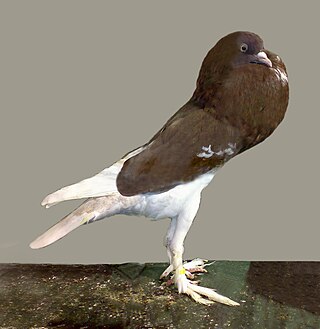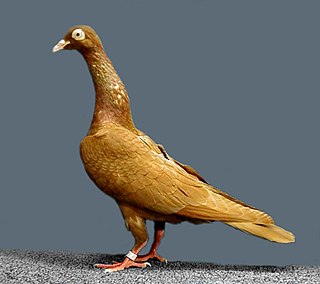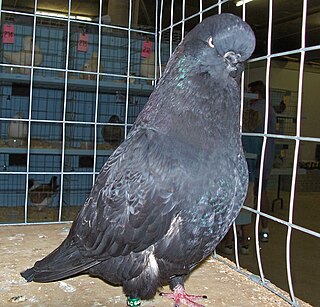Breed clubs are associations or clubs with activities centered on a single, specific breed of a particular species of domesticated animal. The purpose of the association will vary with the species of animal and the goals and needs of the members of the association. Breed associations or clubs may vary in their goals, activities and nomenclature from country to country, even for the same breed. Most domesticated animals, whether they are agricultural animals such as cattle, llamas, poultry, sheep and pigs, or companion animals such as pigeons, horses, cats and dogs, have breed clubs associated with the breed.
Fancy pigeon refers to any breed of domestic pigeon, which is a domesticated form of the wild rock dove. They are bred by pigeon fanciers for various traits relating to size, shape, color, and behavior, and often exhibited at pigeon shows, fairs and other livestock exhibits.

The Fantail is a popular breed of fancy pigeon. It is characterised by a fan-shaped tail composed of 30 to 40 feathers, abnormally more than most members of the dove and pigeon family, which usually have 12 to 14 tail feathers. The breed is thought to have originated in Pakistan, India, China, Japan or Spain. There are several subvarieties, such as the English Fantail, the Indian Fantail, and the Thai Fantail. Charles Darwin used it as one of the examples in the first chapter of his book On the Origin of Species. He believed it was a descendant of the rock dove.

The Bokhara Trumpeter is a breed of fancy pigeon developed over many years of selective breeding. Bokhara Trumpeters, along with other varieties of domesticated pigeons, are all descendants from the rock pigeon . The breed is known for its long muffed (feathered) feet and double crest.

Pigeon keeping or pigeon fancying is the art and science of breeding domestic pigeons. People have practiced pigeon keeping for at least 5,000 years and in almost every part of the world. In that time, humans have substantially altered the morphology and the behaviour of the domesticated descendants of the rock dove to suit their needs for food, aesthetic satisfaction and entertainment.

The Pouter pigeons are domesticated varieties of the rock dove, Columba livia, characterized by a very large, inflatable crop. They are kept as ornamental or fancy breeds, valued for their unusual appearance. There are many varieties of pouter with little in common except for the nature of the crop. The origin of the breed group is unknown, but Pouters have been bred in Europe for at least 400 years.

The English Pouter is a breed of fancy pigeon developed over many years of selective breeding. English Pouters, along with other varieties of domesticated pigeons, are all descendants from the rock pigeon. A breed with an enlarged crop, their distinctiveness was described by Charles Darwin in The Variation of Animals and Plants Under Domestication (1868).

The African Owl is a breed of fancy pigeon developed over many years of selective breeding. They originated in Tunisia (Africa), and were imported into England during the 19th century. The breed is known for its short beak, which gives the breed the "Owl" name due to the size and shape.

The English Short-faced Tumbler is a breed of fancy pigeon developed over many years of selective breeding. English Short-faced Tumblers along with other varieties of domesticated pigeons are all descendants of the rock dove. The English Short-faced Tumbler is one of the oldest breeds referred to in John Moore's book Columbarium: or, The pigeon-house; being an introduction to a natural history of tame pigeons, giving an account of the several species known in England, with the method of breeding them, their distempers and cures.

The Australian Performing Tumbler (APT) is a breed of fancy pigeon.

The Indian Fantail is a breed of fancy pigeon developed over many years of selective breeding. Indian Fantails, along with other varieties of domesticated pigeons are all descendants of the rock dove.

The Trumpeter breeds of fancy pigeon are so named because of their unique vocalizations which sound vaguely like low laughter. Wendell Levi describes this trumpeting vocalization in his book The Pigeon. There are several domesticated varieties that possess this "trumpeting" ability to various degrees. Some of the more popular are:

The Jacobin is a breed of fancy pigeon developed over many years of selective breeding that originated in Asia. Jacobins, along with other varieties of domesticated pigeons, are all descendants of the rock pigeon. It is in the Asian feather and voice pigeon show group. The breed is known for its feathered hood over its head.

The Stargard Shaker, also called Zitterhall, is a breed of fancy pigeon developed over many years of selective breeding. Originally developed in Pomerania. Zitterhals have curved swan-like necks that tremble or shake in a way similar to Fantail pigeons. A Zitterhals pigeon was one of the champions at the 2007 NPA Grand Nationals.

The Ice pigeon is a breed of fancy pigeon developed over many years of selective breeding. Ice pigeons, along with other varieties of domesticated pigeons, are all descendants from the rock pigeon.

The English Long-faced Tumbler is a breed of fancy pigeon developed over many years of selective breeding. English Long-faced Tumblers, along with other varieties of domesticated pigeons, are all descendants of the rock dove.

The English Magpie is a breed of fancy pigeon developed over many years of selective breeding. They can also be very easily spotted in England and in most parts of America. Magpies, along with other varieties of domesticated pigeons, are all descendants from the rock pigeon. The original Magpie was one of the old tumbler varieties, coming via Germany from Denmark about 1900.

The English Trumpeter is a breed of fancy pigeon developed over many years of selective breeding. English Trumpeters, along with other varieties of domesticated pigeons, are all descendants from the rock pigeon. This is one of the most popular breeds in the USA. The English Trumpeter is regarded as one of the most ornamental breeds of fancy pigeon. The most distinguishing feature of this breed are the very large muffs on its feet, which often grow to sizes close to its flight-feathers. Combining a tuft, crest and large muffs on their feet, they are challenging to breed. They are bred in a number of colours which are listed under self, splash and baldhead.

The Barb is a breed of fancy pigeon developed over many years of selective breeding. Barbs, along with other varieties of domesticated pigeons, are all descendants from the rock pigeon . This breed was referred to by Shakespeare. It was also referred to with an illustration in Charles Darwin's Variation of Animals and Plants under Domestication. It has been marked as cruel by many organisations due to the size of its beak which means it has trouble feeding its young and surviving.
















